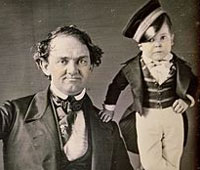
Around 1840 Barnum purchased an establishment in New York City called the American Museum, which housed a strange collection of wax figures, statues, paintings and even a few living animals. Seeing it as an opportunity to make some money in a hurry, he launched the first of many boondoggles by purchasing a fake “mermaid” that supposedly came from the “Fejee Islands.”
Then Barnum heard about a very small person named Charles Stratton. Stratton had stopped growing when he was a baby, but in every other way he continued to develop normally. When Barnum first encountered him, he was four years old and just two feet tall. Barnum entered into an agreement with Stratton’s parents, bumped his age up to eleven, and gave him the name “General Tom Thumb.”
Luckily for Barnum, Stratton proved to be quite a theatrical prodigy. In almost no time, he learned how to sing, dance, swing a cane, and do impersonations (including playing Napoleon). Wearing an overcoat, Barnum would sometimes show up at the American Museum just when a performance was scheduled to begin. Patrons would crowd around him, demanding to know where Tom Thumb was. After a few minutes, Stratton would emerge from an extra-deep pocket in Barnum’s coat: “Here I am, sir!”
Barnum sent Stratton on a tour up and down the East Coast, during which, it was claimed, the boy was seen “by nearly half a million persons.” Next, he took him to England, where, after considerable conniving, he managed to get the dwarf an audience with Queen Victoria. She was amused, and Barnum made sure the press got photos.
This coup turned tiny Tom into quite a sensation. Barnum took him on to Paris, where the child appeared in a tiny carriage pulled by two Shetland ponies. In France, the boy performed his Napoleon imitation only once, at the request of King Louis-Philippe, during a private show at the country palace.
Barnum stayed in Europe with Tom Thumb for nearly three years. How much money he made from the trip is unknown; probably it was the equivalent of tens of millions of dollars in today’s money. Returning to the United States in 1847, Barnum used his newfound wealth to expand his operations in all directions. Before long he went broke. General Tom Thumb, now eighteen years old, volunteered to help, and he and Barnum set off on another tour of Britain, which proved almost as lucrative as the first. Barnum also developed a lecture on “the art of money-getting” and took it on the road.
Sadly, the hallmark of Barnum’s career was that he lied easily and often. He didn’t so much fool the public as indulge it. He turned himself into one more relentlessly promoted exhibit—the Greatest Showman on Earth. As a result he became one of the most celebrated men in America--not in spite of his flimflamming and fakery, but because of them.
Jerry Lincecum is a retired Austin College professor who now teaches classes for older adults who want to write their life stories. A new class begins at Grayson College on Sept. 4 as part of their Community Education program: jlincecum@me.com